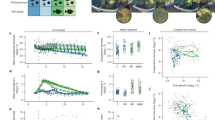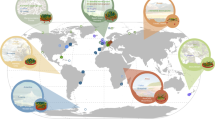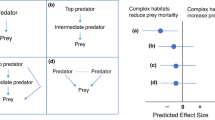Abstract
Competition and predation are the most heavily investigated species interactions in ecology, dominating studies of species diversity maintenance. However, these two interactions are most commonly viewed highly asymmetrically. Competition for resources is seen as the primary interaction limiting diversity, with predation modifying what competition does1, although theoretical models have long supported diverse views1,2,3,4,5. Here we show, using a comprehensive three-trophic-level model, that competition and predation should be viewed symmetrically: these two interactions are equally able to either limit or promote diversity. Diversity maintenance requires within-species density feedback loops to be stronger than between-species feedback loops. We quantify the contributions of predation and competition to these loops in a simple, interpretable form, showing their equivalent potential to strengthen or weaken diversity maintenance. Moreover, we show that competition and predation can undermine each other, with the tendency of the stronger interaction to promote or limit diversity prevailing. The past failure to appreciate the symmetrical effects and interactions of competition and predation has unduly restricted diversity maintenance studies. A multitrophic perspective should be adopted to examine a greater variety of possible effects of predation than generally considered in the past. Conservation and management strategies need to be much more concerned with the implications of changes in the strengths of trophic interactions.
This is a preview of subscription content, access via your institution
Access options
Subscribe to this journal
Receive 51 print issues and online access
$199.00 per year
only $3.90 per issue
Buy this article
- Purchase on Springer Link
- Instant access to full article PDF
Prices may be subject to local taxes which are calculated during checkout




Similar content being viewed by others
References
Chase, J. M. et al. The interaction between predation and competition: a review and synthesis. Ecol. Lett. 5, 302–315 (2002)
Holt, R. D. Spatial heterogeneity, indirect interactions, and the coexistence of prey species. Am. Nat. 124, 377–406 (1984)
Kotler, B. P. & Holt, R. D. Predation and competition: the interaction of two types of species interactions. Oikos 54, 256–260 (1989)
Grover, J. P. & Holt, R. D. Disentangling resource and apparent competition: realistic models for plant-herbivore communities. J. Theor. Biol. 191, 353–376 (1998)
Krivan, V. Competitive co-existence by adaptive predators. Evol. Ecol. Res. 5, 1163–1182 (2003)
MacArthur, R. Species packing and competitive equilibrium for many species. Theor. Popul. Biol. 1, 1–11 (1970)
Chesson, P. MacArthur’s consumer–resource model. Theor. Popul. Biol. 37, 26–38 (1990)
Chesson, P. Mechanisms of maintenance of species diversity. Annu. Rev. Ecol. Syst. 31, 343–366 (2000)
Chesson, P. & Huntly, N. The roles of harsh and fluctuating conditions in the dynamics of ecological communities. Am. Nat. 150, 519–553 (1997)
Holt, R. D., Grover, J. & Tilman, D. Simple rules for interspecific dominance in systems with exploitative and apparent competition. Am. Nat. 144, 741–771 (1994)
Abrams, P. A. High competition with low similarity and low competition with high similarity: exploitative and apparent competition in consumer-resource systems. Am. Nat. 152, 114–128 (1998)
Chesson, P. in Unity in Diversity: Reflections on Ecology after the Legacy of Ramon Margalef (eds Valladares, F. et al.) 119–164 (Fundacion BBVA, 2008)
Holt, R. D. Predation, apparent competition, and the structure of prey communities. Theor. Popul. Biol. 12, 197–229 (1977)
Haygood, R. Coexistence in MacArthur-style consumer–resource models. Theor. Popul. Biol. 61, 215–223 (2002)
Kuang, J. J. & Chesson, P. Predation–competition interactions for seasonally recruiting species. Am. Nat. 171, E119–E133 (2008)
Hutchinson, G. E. Homage to Santa Rosalia or why are there so many kinds of animals? Am. Nat. 93, 145–159 (1959)
Kuang, J. J. & Chesson, P. Coexistence of annual plants: generalist seed predation weakens the storage effect. Ecology (in the press)
Soule, M. E. & Terborgh, J. Conserving nature at regional and continental scales—a scientific program for North America. Bioscience 49, 809–817 (1999)
Sala, E. Top predators provide insurance against climate change. Trends Ecol. Evol. 21, 479–480 (2006)
Schmitz, O. J. Predators have large effects on ecosystem properties by changing plant diversity, not plant biomass. Ecology 87, 1432–1437 (2006)
Johnson, C. N., Isaac, J. L. & Fisher, D. O. Rarity of a top predator triggers continent-wide collapse of mammal prey: dingoes and marsupials in Australia. Proc. R. Soc. B 274, 341–346 (2007)
Borrvall, C. & Ebenman, B. Early onset of secondary extinctions in ecological communities following the loss of top predators. Ecol. Lett. 9, 435–442 (2006)
Myers, R. A., Baum, J. K., Shepherd, T. D., Powers, S. P. & Peterson, C. H. Cascading effects of the loss of apex predatory sharks from a coastal ocean. Science 315, 1846–1850 (2007)
Heithaus, M. R., Frid, A., Wirsing, A. J. & Worm, B. Predicting ecological consequences of marine top predator declines. Trends Ecol. Evol. 23, 202–210 (2008)
Acknowledgements
This work was supported by National Science Foundation grants DEB-0542991 and DEB-0717222.
Author Contributions P.C. and J.J.K. jointly developed the model. P.C. derived the coexistence conditions and wrote the first draft of the manuscript. P.C. and J.J.K. jointly prepared the figures and all revisions of the manuscript.
Author information
Authors and Affiliations
Corresponding authors
Supplementary information
Supplementary Information
The file contains Supplementary Notes. (PDF 170 kb)
Rights and permissions
About this article
Cite this article
Chesson, P., Kuang, J. The interaction between predation and competition. Nature 456, 235–238 (2008). https://doi.org/10.1038/nature07248
Received:
Accepted:
Issue Date:
DOI: https://doi.org/10.1038/nature07248
This article is cited by
-
Taxonomic dependency and spatial heterogeneity in assembly mechanisms of bacteria across complex coastal waters
Ecological Processes (2024)
-
Reduced predation pressure as a potential driver of prey diversity and abundance in complex habitats
npj Biodiversity (2023)
-
The effect of non-linear competitive interactions on quantifying niche and fitness differences
Theoretical Ecology (2023)
-
A common measure of prey immune function is not constrained by the cascading effects of predators
Evolutionary Ecology (2023)
-
A general approach for quantifying microbial effects on plant competition
Plant and Soil (2023)
Comments
By submitting a comment you agree to abide by our Terms and Community Guidelines. If you find something abusive or that does not comply with our terms or guidelines please flag it as inappropriate.



